V3 Gaming PC Avenger Review: A New Challenger Appears
by Dustin Sklavos on May 16, 2012 2:20 AM ESTApplication and Futuremark Performance
Given the massive 4.75GHz overclock on the Intel Core i7-3820, the SF-2200-based SSDs in RAID 0, and the NVIDIA GeForce GTX 680, it's probably reasonable to assume our Futuremark testing is going to skew heavily in the V3 Avenger's favor. Keep in mind that these are synthetics, however, and PCMark has a habit of substantially inflating scores on fast storage subsystems.

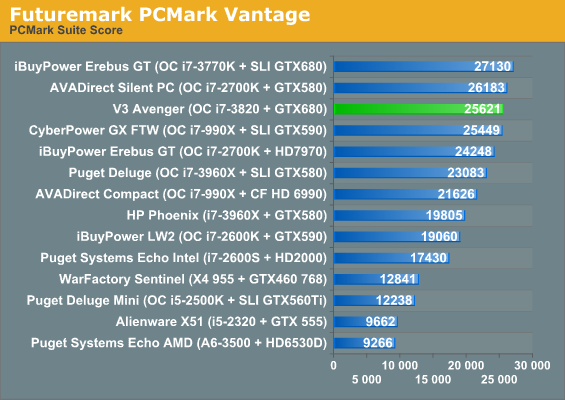
Interestingly, the combined read speeds of the two Corsair Force GT SSDs don't give the V3 Avenger as big of an edge as we'd expect. It seems as though you're still better off running a single large SSD rather than striping two together, which is for the most part in line with what I expected.
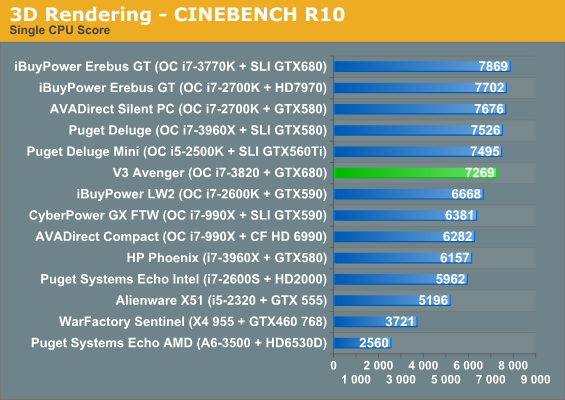
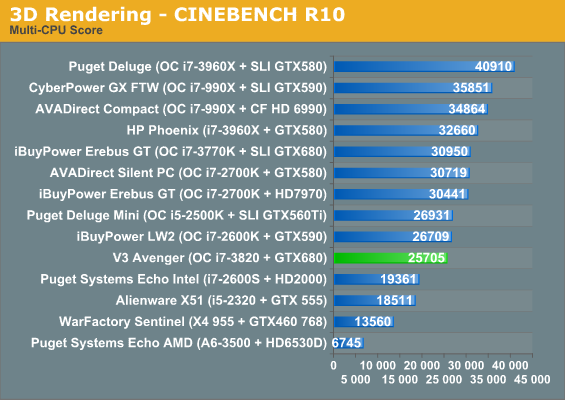
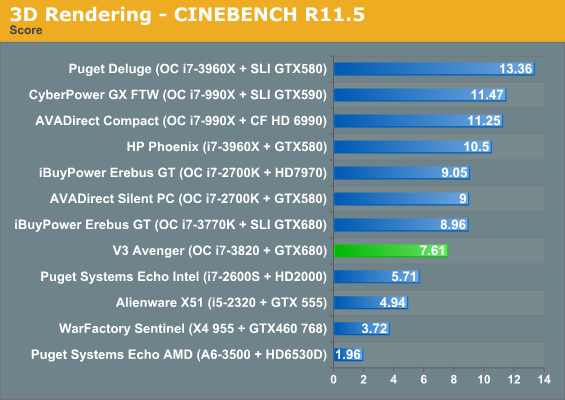
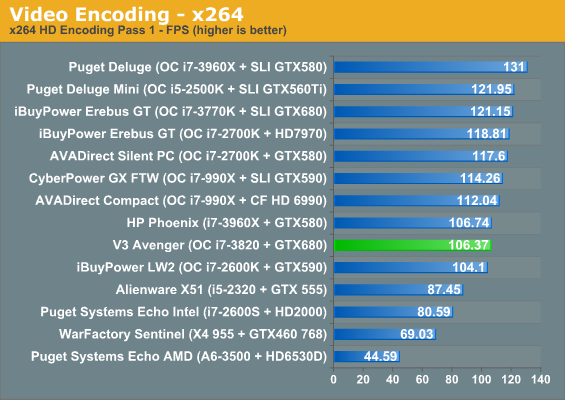
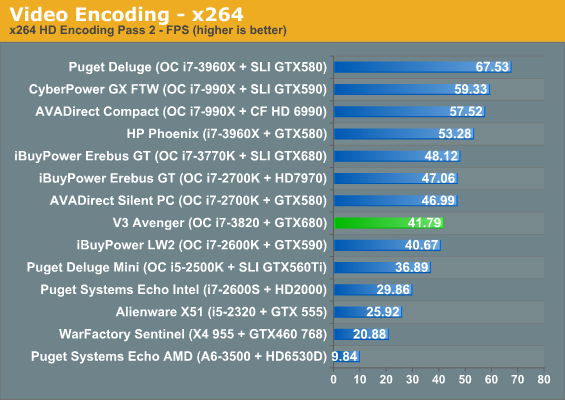
Perhaps more interestingly, the beefy i7-3820 has trouble competing with similarly clocked Sandy Bridge processors, and even Intel's first generation hex-cores continue to walk away from the quads in benchmarks that can take advantage of the extra threads.
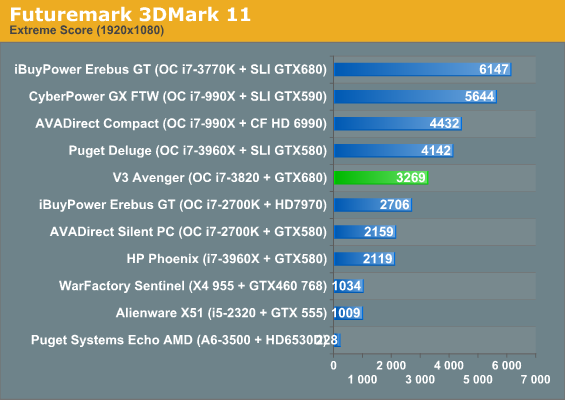
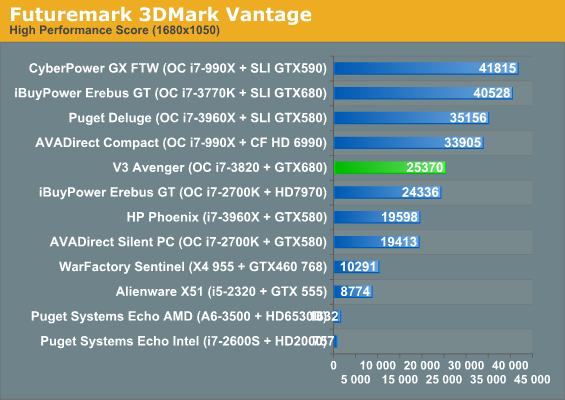
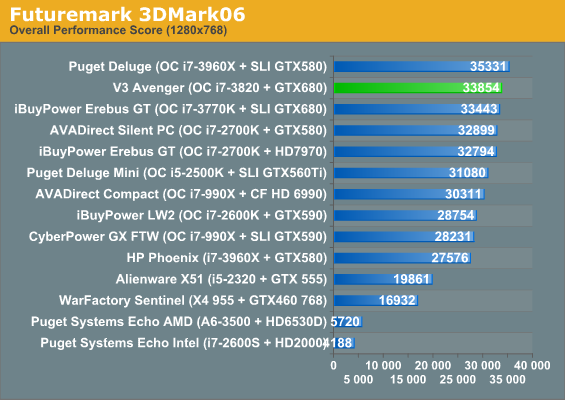
The situation gets a bit rosier in the 3DMarks, where the GeForce GTX 680 can stretch its legs. It only falls behind systems with more than one GPU, as it should.










32 Comments
View All Comments
StruckXx - Wednesday, June 6, 2012 - link
Yeah, for a vendor they are way overcharging. I buy my computers from http://IronsideComputers.com, and their prices are much more reasonable. I compared them with V3, and the price is nearly $300 cheaper and they are offering free liquid cooling and a better motherboard.Sunrise089 - Wednesday, May 16, 2012 - link
According to the introduction this PC is supposed to avoid "paying out the nose for a system that left the price-performance curve eating the dust in its speedy wake" and that has been "designed to be as balanced a build as possible."You conclude though that "the Avenger is the top-of-the-line, 'I have too much money' model, while the Convoy is the more aggressive workhorse. Ivy Bridge and Z77 (when the line is updated with them) are going to give you more bang for your buck anyhow."
So which is it? We all know this isn't "as balanced of a build as possible," so please don't include such language if you don't think it's true. Just because a manufacturer offers some talking points to make your job easier doesn't mean you have to fall for them.
There's no shame in just opening the article by telling us that "the Avenger is another high-end boutique PC that tries to offer enough to justify it's considerable price" or something similar. It would be a lot more honest...
JarredWalton - Wednesday, May 16, 2012 - link
"What we have in house today is a system they believe has been designed to be as balanced a build as possible."Saying that V3 is claiming this is a "balanced" system is all that the intro states; that's their supposed goal and listing that goal and then evaluating how well they succeed at achieving it is perfectly reasonable. And in the conclusion as well as elsewhere, Dustin points out several ways in which the system isn't particularly balanced. I don't see any "parroting of talking points" here. If that's all Dustin were doing, the review would be a lot more favorable.
ImSpartacus - Wednesday, May 16, 2012 - link
Yeah, I agree. I had different expectations after reading that intro. If I hadn't read that intro, I think I might've been able to judge it differently.When I think "bang-for-buck" in the boutique realm, I imagine a machine with a cheap stock quad core CPU, a bitchin single GPU, a moderate amount of RAM and an adequate storage solution.
This machine only checks one of those boxes.
DanNeely - Wednesday, May 16, 2012 - link
Same here. The description V3 gave is something I'd put on a $1000-1500 DIY/$1200-1800 boutique system.Tunnah - Wednesday, May 16, 2012 - link
The CPU isn't any more expensive than the none-E part so it was a good choice, you have a stronger CPU and also the better chipset, you've not ended up paying much extra for it.cknobman - Wednesday, May 16, 2012 - link
I would never pick a build with a SSD setup like that.Then to make it worse their overclock is terrible (not speed but the voltage increase they used to get it).
Voldenuit - Wednesday, May 16, 2012 - link
"What we have in house today is a system they believe has been designed to be as balanced a build as possible. "Balanced? A sensible *gaming* build would have been a Core i5 (or even an i3!) and a GeForce 670 tops. And replace those RAIDed 60 GB Sandforce drives with a single 128 GB Samsung 830, Plextor M3 or Corsair Performance Pro.
kyuu - Wednesday, May 16, 2012 - link
Yeah, I have to agree with other posters: this is not a "balanced" build. The Sandy Bridge-E by itself pretty much precludes that designation. And you certainly are paying out the nose for a system that "left the price-performance curve eating the dust in its speedy wake."Although I disagree with other posters in that I think the case looks good.
sjankis630 - Wednesday, May 16, 2012 - link
Can someone tell me why they put together a top level system and used Windows 7 Home Premium 64bit? Isn't there a limit on the ram that Windows 7 Home Premium can accept?I thought it was 16GB. Knowing an enthusiast will likely want to upgrade, why not use Windows Professional with a 192GB limit?
http://msdn.microsoft.com/en-us/library/windows/de...